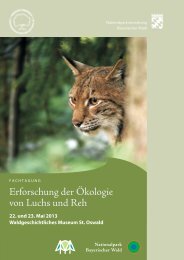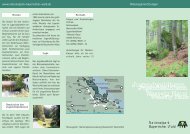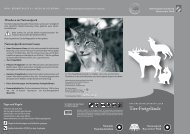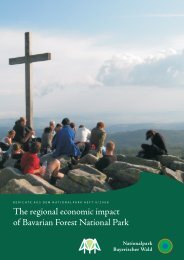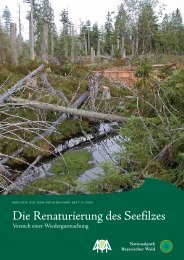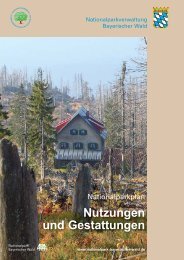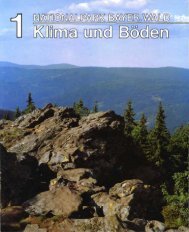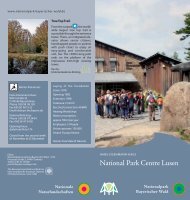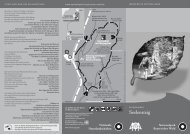Preparation of the National Park Plan - Nationalpark Bayerischer Wald
Preparation of the National Park Plan - Nationalpark Bayerischer Wald
Preparation of the National Park Plan - Nationalpark Bayerischer Wald
Create successful ePaper yourself
Turn your PDF publications into a flip-book with our unique Google optimized e-Paper software.
26 NATIONAL PARK PLAN 2010<br />
Through <strong>the</strong> German-Czech Youth Forum, young people gain direct experience <strong>of</strong> nature in <strong>the</strong> Bavarian Forest<br />
– Šumava <strong>National</strong> <strong>Park</strong> region and <strong>the</strong> wilderness becomes a familiar environment (Photo: Hans Kiener)<br />
5.4. Promotion <strong>of</strong> transboundary co-operation<br />
The Bavarian Forest and Šumava <strong>National</strong> <strong>Park</strong>s have<br />
a unique opportunity to create a cross border bilateral national<br />
park <strong>of</strong> European importance. Close cooperation in <strong>the</strong><br />
realisation <strong>of</strong> <strong>the</strong> objectives <strong>of</strong> both national parks is <strong>the</strong>refore<br />
essential. The most important elements in <strong>the</strong> development <strong>of</strong><br />
a bilateral national park are agreed objectives and joint activities<br />
in nature protection, education, research, recreation and culture.<br />
Examples <strong>of</strong> cross border projects <strong>of</strong> <strong>the</strong> Bavarian Forest and<br />
Šumava <strong>National</strong> <strong>Park</strong>s include <strong>the</strong> forest hiking area in <strong>the</strong><br />
Finsterau/Bučina area, <strong>the</strong> Bavarian-Czech information and<br />
meeting centre at <strong>the</strong> border railway station in Bayerisch<br />
Eisenstein / Železná Ruda, cooperation between <strong>the</strong> two ranger<br />
services, joint Natura 2000 management planning and <strong>the</strong> joint<br />
lynx research project. These and <strong>the</strong> already existing cross<br />
border paths can also make a significant contribution to<br />
understanding between peoples and acceptance <strong>of</strong> <strong>the</strong> national<br />
parks in <strong>the</strong> region.<br />
5.5. Support for measures for improving <strong>the</strong> yields in<br />
agriculture and forestry in <strong>the</strong> areas around<br />
<strong>the</strong> national park<br />
There are many interactions between <strong>the</strong> national park and<br />
its surrounding areas. The national park is home to many rare<br />
and endangered animal species, whose habitat does not end at<br />
<strong>the</strong> borders <strong>of</strong> <strong>the</strong> national park. For many <strong>of</strong> <strong>the</strong>m, <strong>the</strong><br />
surrounding areas are an important extension <strong>of</strong> <strong>the</strong>ir habitat.<br />
In <strong>the</strong> winter months, when <strong>the</strong>re is considerable snow in <strong>the</strong><br />
national park, <strong>the</strong> surrounding areas are very important to<br />
many animal species as areas <strong>of</strong> refuge. The farmed landscapes<br />
around <strong>the</strong> national park can <strong>the</strong>refore make a considerable<br />
contribution to <strong>the</strong> protection <strong>of</strong> species. For this reason,<br />
environmentally sustainable measures for improvements in<br />
yields from agriculture and forestry in <strong>the</strong> areas surrounding<br />
<strong>the</strong> national park would be sensible (e.g. direct marketing).



